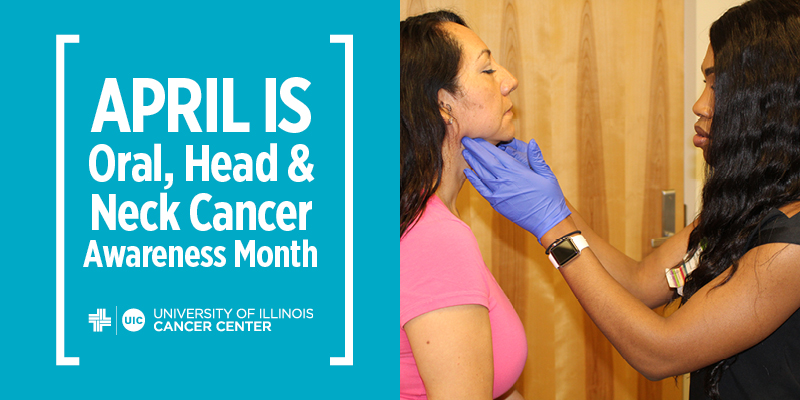
More than 3% of cancer cases diagnosed at the University of Illinois Cancer Center – and 2.5% in Illinois – between the years 2012-2016 were oropharyngeal cancers, a disease that begins in the middle part of the throat behind the mouth.
April is Oral, Head and Neck Cancer Month, and people are encouraged to check with a doctor or dentist should they discover a lump or a wound that doesn’t heal; they have a sore throat that won’t go away; swallowing becomes difficult; and their voice changes. Overall, oral, head and neck cancers – considered to be those in the larynx, throat, lips, mouth, nose and salivary glands – account for nearly 4% of all cancers in the United States.
Health disparities are preventable but they remain. Of the oropharyngeal cancer patients diagnosed at the UI Cancer Center between 2012-2016 (the latest figures available), 66% were people of color (39% African American, 18% Hispanic, and 9% Asian/Pacific Islander), compared to 33% Non-Hispanic Whites. Of those cases, 50% were diagnosed at stages 2-4, said Vida Henderson, PhD, PharmD, MPH, MFA, director of the UI Cancer Center’s Community Engagement and Health Equity Office.
Nearly 75% of head and neck cancer diagnosed today are due to tobacco and alcohol use, with infection from the human papillomavirus infection (HPV) also playing a significant role. The disease is expected to claim the lives of 14,500 Americans this year, according to the National Cancer Institute. It was anticipated that there would be 550,000 new cases diagnosed and about 300,000 deaths from these cancers worldwide in 2019.
Head and neck cancers are more than twice as common among men as they are women. In Cook County between the years 2012-2016, there were 17.2 cases per 100,000 males, compared to 6.3 per 100,000 females. They are also diagnosed more often among people over age 50 than they are among younger people. Cancers of the oropharynx (tonsil and base of tongue) are increasing in incidence, particularly in younger smokers. It is estimated that these cancers alone will account for more than 40,000 cases per year in the United States, said the Head and Neck Cancer Alliance.
Illinois ranks 27th in the United States for oral cavity and pharynx cancers, and 2.8 per 100,000 died from the disease in 2016. For every 100,000 people in Cook County, three died of oral cavity and pharynx cancer over those years, ranking Cook County ninth of all Illinois counties. More than four per 100,000 deaths were male (compared to 1.5 female), and more than three per 100,000 were African American.
To commemorate the month, Virginie Achim, MD, UI Cancer Center member and assistant professor in otolaryngology-head and neck surgery at UI Health, served as a guest on the “Dr. In The House with Dr. Terry Mason” on WVON 1690 AM. Achim’s specialty is head and neck surgical oncology, microvascular reconstruction, and transoral robotic surgery, as well as thyroid/parathyroid surgery. Robert Winn, MD, director of VCU Massey Cancer Center and former director of the UI Cancer Center, was also a guest on the show, which, along with Mason, is hosted by Karriem Watson, DHSc, MS, MPH, associate director of community outreach and engagement at the UI Cancer Center.
Extensive research on oral and head/neck cancer is being conducted in numerous colleges throughout the University of Illinois at Chicago – Dentistry, Nursing, Medicine, just to name a few. This includes, but is not limited to:
- Studies to better understand how cancer treatment affects quality of life following therapy. “Assuming that two different types of treatment offer the same cure rate, does one treatment offer better functional outcomes over another?” Achim said.
- Research focused on mitigating the side effects of treatment. Current trials involve decreasing radiation side effects such as mucositis once the drug has been administered.
- Studies utilizing different chemotherapy/immunotherapy regimens for patient with advanced head and neck cancer. This research is often multi-institutional that evaluates survival benefits of various chemo/immunotherapy drugs for patients with recurrent or metastatic disease, Achim said.
- Research on how to improve the incidence and survival of oral/pharynx cancers using the results of demographic and epidemiology records.
- Using several hundred records for oral cancer/head and neck screening from 2017-2019, investigators from the College of Dentistry, Department of Oral Maxillofacial Surgery, Oral Medicine, College of Medicine, Department of Otolaryngology, Mile Square and the UI Cancer Center are determining which Chicago areas have the highest numbers of oral/head and neck cancers. “Our plan is to evaluate for demographics: gender, age, community area, race/ethnicity,” said Joel Schwartz, DMD, DMedSc, UI Cancer Center member and professor of oral medicine and diagnostic sciences. “We will also obtain results to exhibit the presence of pathology in the oral cavity, ear/nose/throat – including HPV history in a portion of the records – and head and neck. Using the results from this database, we will analyze for epidemiology associations which can be determined using Chicago Health Atlas 2.0 and a variety of indicators for each community area.” Non-Hispanic Black (NHB) individuals in Chicago have the highest number of cases, and NHB males have the most deaths from oral/pharynx cancer compared to other ethnicities. This is important, Schwartz said, because “UI Health and the UI Cancer Center is dedicated to serving this population.”
